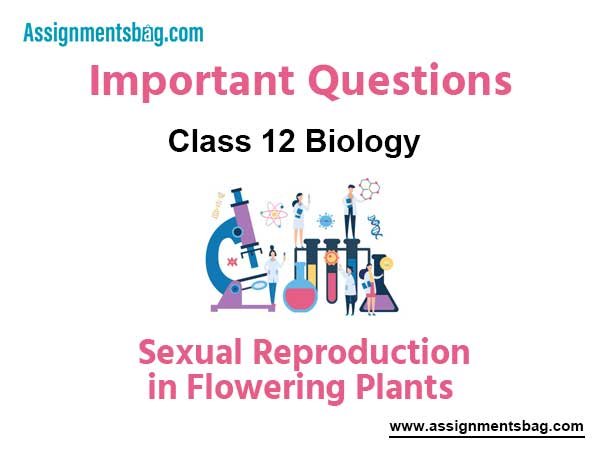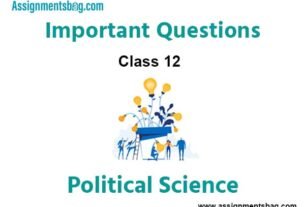Please refer to Sexual Reproduction In Flowering Plants Class 12 Biology Important Questions with solutions provided below. These questions and answers have been provided for Class 12 Biology based on the latest syllabus and examination guidelines issued by CBSE, NCERT, and KVS. Students should learn these problem solutions as it will help them to gain more marks in examinations. We have provided Important Questions for Class 12 Biology for all chapters in your book. These Board exam questions have been designed by expert teachers of Standard 12.
Class 12 Biology Important Questions Sexual Reproduction In Flowering Plants
Very Short Answer Questions
Question. Draw a diagram of a matured microspore of an angiosperm. Label its cellular components only.
Ans

Question. A bilobed, dithecous anther has 100 microspore mother cells per microsporangium. How many male gametophytes this anther can produce?
Ans. The bilobed anther can produce 1600 male gametophytes.
Question. The diploid number of chromosomes in an angiospermic plant is 16. What will be the number of chromosomes in its endosperm and antipodal cells?
Ans. Endosperm—24 chromosomes, Antipodals—8 chromosomes.
Question. Give an example of a plant which came into India as a contaminant and is a cause of pollen allergy.
Ans. Parthenium or Carrot grass.
Question. Name the part of the flower which the tassels of the corn-cob represent.
Ans. Style and stigma
Question. Write the function of coleoptile.
Ans. It protects the plumule of the monocot embryo.
Question. The microscopic pollen grains of the past are obtained as fossils. Mention the characteristic of the pollen grains that makes it happen.
Ans. The exine of pollen grains have an outermost hard layer composed of a chemical, sporopollenin.
It is highly resistant to high temperature, strong acids and alkali. So, pollen grains are obtained as fossils.
Question. What are chasmogamous flowers? Can cross-pollination occur in cleistogamous flowers? Give reasons for your answer.
Ans. Chasmogamous flowers are open flowers with exposed stamens and stigma which facilitate cross-pollination.
No cross-pollination occurs in cleistogamous flowers as these flowers are closed and never open and thus no transfer of pollen from outside to stigma of the flower is possible.
Question. Mention two strategies evolved to prevent self-pollination in flowers.
Ans. The two strategies evolved to prevent self-pollination in flowers are:
(i) Maturation of anthers and stigma at different time periods in a bisexual flower prevents selfpollination (dichogamy).
(ii) Production of unisexual flowers.
Question. What is bagging technique? How is it useful in a plant breeding programme?
Ans. It is the covering of female plant with butter paper germ to avoid their contamination from foreign pollens during breeding programme.
Question. Why is apple called a false fruit? Which part(s) of the flower forms the fruit?
Ans. False fruits are those fruits in which accessory floral parts also contribute to fruit formation. In apple, the thalamus also contributes to fruit formation. Therefore, it is called a false fruit. The fruit develops from the ovary of the flower.
Question. Define parthenocarpy.
Ans. Parthenocarpy is an economically important process in which seedless fruit is formed without fertilisation, for example, banana.
Question. In a case of polyembryony, if an embryo develops from the synergid and another from the nucellus, which is haploid and which is diploid?
Ans. Synergid embryo is haploid and nucellar embryo is diploid.
Short Answer Questions
Question. In the T.S. of a mature anther given below, identify “a” and “b” and mention their function. (1)
Ans. a—Sporogenous tissue: It forms pollen grains.
b—Tapetum: It provides nourishment to the developing pollen grains.
Question. Name the organic materials the exine and intine of an angiosperm pollen grains are made up of. Explain the role of exine.
Ans. Exine is made up of sporopollenin and intine is made up of cellulose and pectin. Exine is the most resistant organic material and can withstand high temperature, acidic and alkali environment.
Question. “Pollen grains in wheat are shed at 3-celled stage while in peas they are shed at 2-celled stage.”Explain. Where are germ pores present in a pollen grain?
Ans. At the time of shedding wheat pollen consists of one vegetative and two male gametes, which is the 3-celled stage. While pea pollen consists of one vegetative and one generative cell which is the 2-celled stage. Germ pores are present on the exine where sporpollenin is absent.
Question. What is triple fusion? Where and how does it take place? Name the nuclei involved in triple fusion.
Ans. Triple fusion is fusion of one male gamete and two polar nuclei (or secondary nucleus; if the two have already fused) in the central cell of embryo sac to form primary endosperm nucleus.
It takes place in the central cell of an embryo sac. Three nuclei are involved in triple fusion, i.e., one male nucleus and two polar nuclei in the central cell.
Question. Gynoecium of a flower may be apocarpous or syncarpous. Explain with the help of an example each.
Ans. The gynoecium represents the female reproductive part of the flower. When there are more than one pistil, if the pistils are fused together, the flower is said to be syncarpous and if the pistils are free, it is said to be apocarpous. For example, pistil of Papaver is syncarpous and that of Michelia is apocarpous.
Question. Name all the haploid cells present in an unfertilised mature embryo sac of a flowering plant.
Write the total number of cells in it.
Ans. The haploid cells in an unfertilised mature embryo sac are: egg cell, synergids, antipodals and central cell. There are 7 cells in total.
Question. Draw a diagram of pollen grain with germ tube and two male gametes. (8)
Ans.
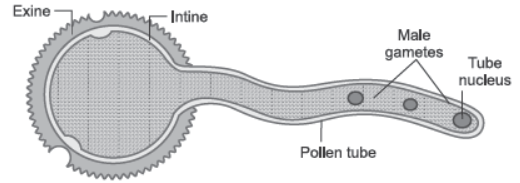
Question. Which is the triploid tissue in a fertilised ovule? How is the triploid condition achieved?
Ans. The triploid tissue in the ovule is the endosperm. Its triploid condition is achieved by the fusion of two polar nuclei and one nucleus of male gamete, referred to as triple fusion.
Question. Fill in the following labels with the type of cell function.

Ans. X—Meiosis (Reduction division); A—Mitosis; B—Mitosis; C—Mitosis; D—Cells reorganised as polar nuclei, antipodals and egg apparatus.
Question. Differentiate between albuminous and non-albuminous seeds, giving one example of each.
Ans. Albuminous seeds have residual endosperm in them. For example, maize.
Non-albuminous seeds do not have any residual endosperm. For example, pea.
Long Answer Questions
Question. (a) How does cleistogamy ensure autogamy?
(b) State one advantage and one disadvantage of cleistogamy to the plant.
Ans. (a) Cleistogamous flowers do not open. Therefore, the pollens have to land on the stigma of the same flower. This ensures autogamy.
(b) Advantage: Self-pollination is assured, thus ensuring seed formation.
Disadvantage: Least variations observed and it leads to inbreeding depression.
Question. Rose plants produce large, attractive bisexual flowers but they seldom produce fruit. On the other hand, Lady’s finger produces plenty of fruits. Analyse the reasons for failure of fruit formation in rose.
Ans. Failure of fruit formation in rose may be due to several reasons. Some of them are:
(a) Inability to produce viable pollens.
(b) Absence of functional egg.
(c) Presence of abortive ovules.
(d) Being hybrids, the meiotic process may be abnormal resulting in non-viable gametes.
(e) There may be self-incompatibility.
(d) There may be internal barriers for pollen tube growth and/or fertilisation.
Question. Draw a labelled diagram of the sectional view of a mature pollen grain in angiosperms. Explain the functions of its different parts.
Ans.
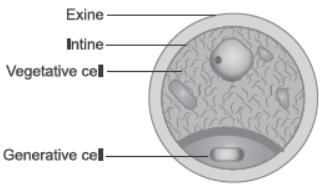
Functions:
(i) Pollen grains are generally spherical with a prominent two-layered wall. The hard outer layer is called exine made up of sporopollenin, which is a resistant organic material.
(ii) Exine can withstand high temperature, strong acids and alkali, thus provide protection.
(iii) It has prominent aperture called germ pore, through which pollen tube comes out.
(iv) Vegetative cell has abundant food reserve.
(v) G enerative cell divides mitotically giving rise to two male gametes, before pollen grains are shed (3-celled stage)
Question. (a) Where is microsporangium located in an angiosperm ? State the functions of tapetum and the other three layers of microsporangium?
(b) Describe the structure of the male gametophyte produced as a result of microsporogenesis.
(c) State the functions of each part of the male gametophyte.
Ans. (a) Microsporangium is located in the anther lobe.
Tapetum nourishes the developing pollen grain.
The other three layers of microsporangium, i.e., epidermis, endothecium and middle layers protect and dehisce the microsporangium.
(b) Structure of Pollen grain/male gemetophyte.
(i) Outer wall layer of the male gametophyte is called exine. It is a hard layer, made of sporopollenin. It protects the pollen grain.
(ii) Inner wall layer is called as intine. It is made up of cellulose and pectin.
(iii) Vegetative cell is rich in food reserve. It helps in formation of pollen tube.
(iv) Generative cell is smaller and has dense cytoplasm and a nucleus. It forms the two male gametes.
Question. Describe in sequence the events that lead to the development of a 3-celled pollen grain from microspore mother cell in angiosperms.
Ans. Refer to Basic Concept Point 3 (Microsporogenesis and Pollen grains).
Question. (a) How does microspore mother cell develop into mature pollen grain in angiosperms?
(b) Describe the structure of a mature pollen grain and draw a labelled diagram of its twocelled stage.
Ans. (a) Microsporangia develop and get transformed into pollen sacs.
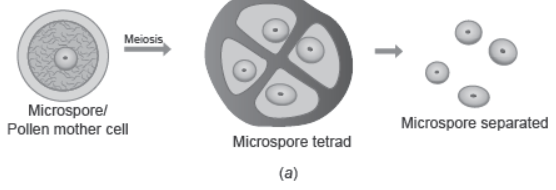
(b) Pollen Grains
♦ Pollen grains are generally spherical in structure.
♦ They possess two prominent wall layers—outer exine and inner intine.
♦ The exine is a hard layer made of sporopollenin which is one of the most resistant organic material present in nature. It can withstand high temperature and strong acids and alkalis. Even enzymes cannot degrade sporepollenin and hence pollens are preserved as fossils.
♦ The inner thin layer of intine is made up of cellulose and pectin.
♦ The exine has aperture where sporopollenin is absent, called germ pores.
♦ The newly differentiated pollen grain has a central nucleus and dense cytoplasm.
♦ Pollen grain is the first cell of a male gametophyte.
♦ The protoplast increases in size and mitotically divides into two unequal cells—
(a) bigger vegetative cell which is rich in food reserve and large irregularly shaped nucleus, and
(b) smaller spindle-shaped generative cell with dense cytoplasm and a nucleus. This is called the 2-celled stage.
♦ In majority angiosperms, pollens are released in this 2-celled stage, whereas in other species, the generative cell divides into 2 male gametes and thus pollen is said to be in 3-celled stage.

Question. Differentiate between geitonogamy and xenogamy in plants. Which one between the two will lead to inbreeding depression and why?
Ans.
| S.No. | Geitonogamy | Xenogamy |
| (i) | It is transfer of pollen grains from the anther to the stigma of another flower of same plant. | It is transfer of pollen grains from the anther to the stigma of a different plant. |
| (ii) | The pollen grains are genetically similar to the plant | The pollen grains are genetically different from the plant. |
Geitonogamy will lead to inbreeding depression because the pollen grains are genetically similar, which results in inbreeding. Continued inbreeding will thus reduce fertility and productivity.
Question. Is pollination and fertilisation necessary in apomixis? Give reasons.
Ans. No, they are not necessary. Apomixis is actually an alternative to sexual reproduction, although the female sexual apparatus is used in the process. In apomicts, embryos can develop directly from the nucellus or synergid or egg. Therefore, there is no need for either pollination or fertilisation.
Question. (a) Explain the post-pollination events leading to seed production in angiosperms.
(b) List the different types of pollination depending upon the source of pollen grain.
Ans. (a) Refer to Basic Concepts Points 6, 8 and 9.
(b) The different types of pollination are:
(i) Autogamy/self-pollination
(ii) Geitonogamy.
(iii) Xenogamy/cross-pollination.
Question. (a) Describe any two devices in a flowering plant which prevent both autogamy and geitonogamy.
(b) Explain the events upto double fertilisation after the pollen tube enters one of the synergids in an ovule of an angiosperm.
Ans. (a) (i) Dioecy: It refers to the production of unisexual flowers in different plants.
(ii) Self-incompatibility: It refers to the condition where pollens fail to pollinate the stigma of same flower.
(b) Double Fertilisation/Triple Fusion
- On reaching synergid, pollen tube releases the two male gametes into cytoplasm of synergid.
- One of the male gamete fuses with egg nucleus to form a diploid cell called zygote. This event is called syngamy.
- Other male gamete fuses with polar nuclei at the centre to produce a triploid primary endosperm nucleus (PEN). This is termed as triple fusion.
- As syngamy and triple fusion take place simultaneously in the embryo sac, it is termed as double fertilisation.
- The central cell after triple fusion forms primary endosperm cell (PEC) which later develops into endosperm.
- The zygote later develops into an embryo.
Question. (a) Explain the characteristic features of wind-pollinated flowers. How are insect-pollinated flowers different from them?
(b) Explain the mutually rewarding relationship between Yucca plant and a species of moth.
Ans. (a) Wind-pollinated flowers have light-weight, non-sticky, dry and winged pollens. The wellexposed stamens help in easy dispersal of pollen grains. The stigma is sticky, large and feathery to trap pollen grains floating in the air. Numerous flowers are packed together to form inflorescence.
Insect-pollinated flowers are large, sticky and brightly coloured with honey and nectar glands to attract insects. They are highly fragrant and the stigma is sticky.
(b) Both Yucca plant and the moth cannot complete their life cycles without each other. The moth deposits its eggs in the locule of the ovary and the flower in turn, gets pollinated by the moth.
The larvae of the moth come out of the eggs as the seeds start developing.
Question. Make a list of any three outbreeding devices that flowering plants have developed and explain how they help to encourage cross-pollination.
Ans. (i) Production of unisexual flowers/dioecious plants, cross pollination ensured.
(ii) Self incompatibility, genetic mechanism preventth e pollen germination on the stigma of the same flower.
(iii) Anther and stigma are placed at different positions, so the pollen can not come in contact with the stigma of the same flower.
